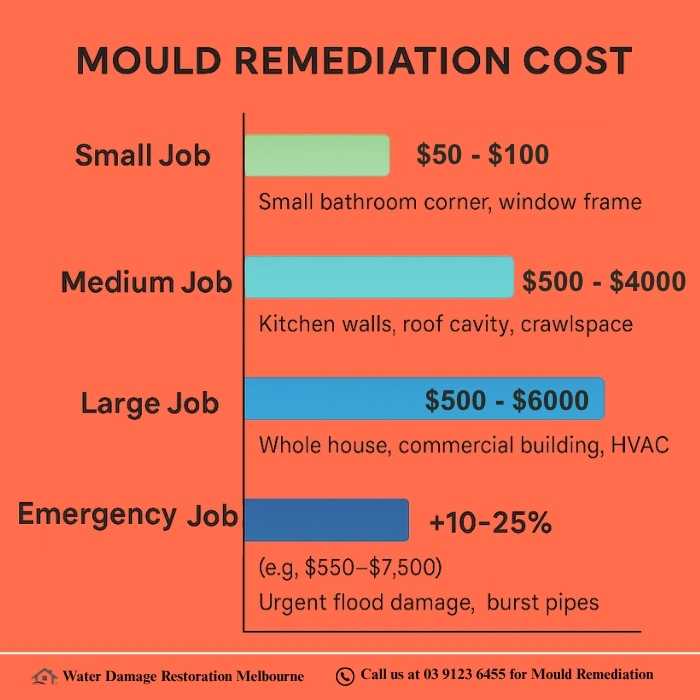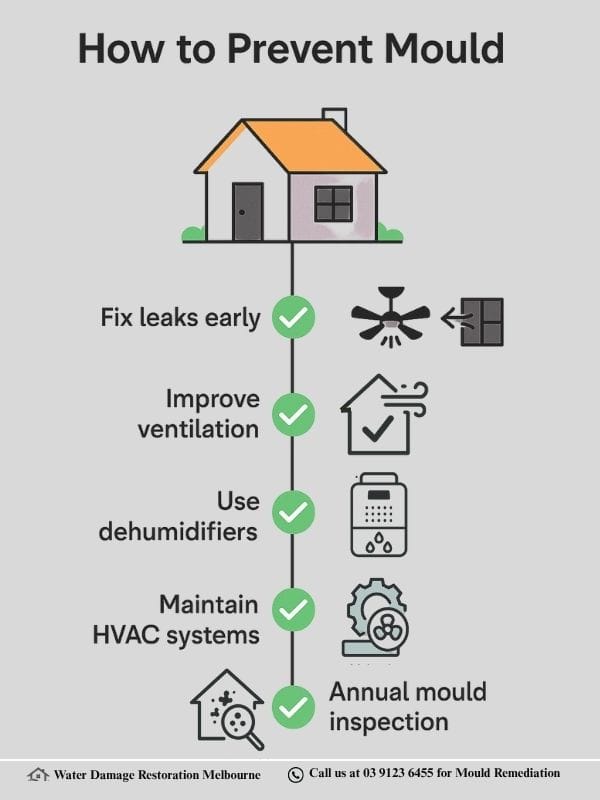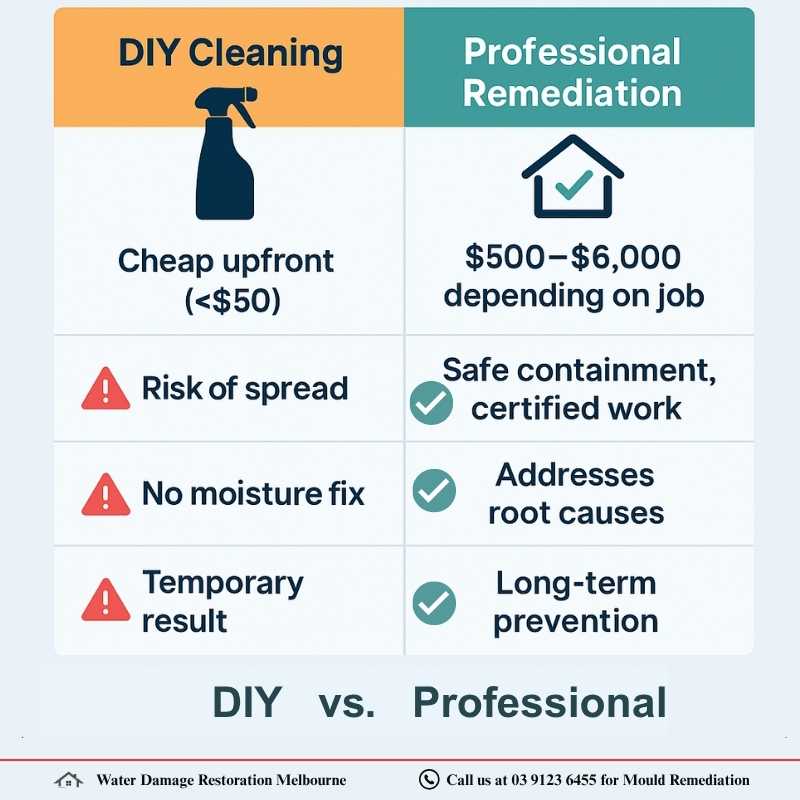At Water Damage Restoration Melbourne, we know how annoying (and sometimes scary) mould can be. We’ve helped heaps of homeowners, renters, property managers, and businesses across Melbourne deal with mould safely and for good.
In this article, we’ll explain what mould remediation involves, what factors affect the cost, why professional help is essential, and how you can prevent mould from coming back. The insights shared here come from our hands-on experience, as well as insights from trusted partners in the remediation and building maintenance industry.
Table of Contents
ToggleKey Takeaways
- Mould removal in Melbourne typically costs $500–$6,000, depending on job size and complexity.
- Minor bathroom mould patches may cost just $50–$100.
- Medium jobs like, kitchens, crawlspaces, or roof cavities usually cost $500–$4,000.
- Large or complex jobs like, whole-house or commercial treatments can exceed $6,000, especially with structural or HVAC work.
- Expect to pay 10–25% extra, roughly $550–$7,500, for urgent remediation.
- Larger or hidden mould, black mould, specialised equipment, and extra services like air testing or duct cleaning, will increase the price.
What Is Mould Remediation?
Mould remediation is the complete process of identifying, removing, and preventing indoor mould growth in homes, apartments, commercial buildings, or workplaces. It goes beyond simple mould removal or cleaning.
Professionally, mould remediation involves:
- Identifying the source of moisture such as roof leaks, plumbing leaks, rising damp, or poor ventilation, that allows mould to grow.
- Assessing the extent and type of mould, including black mould (Stachybotrys chartarum), common household moulds like Aspergillus or Penicillium, and mould in hidden areas like crawlspaces, roof cavities, or air-conditioning ducts.
- Safely removing contaminated materials and treating affected surfaces, using specialised equipment like HEPA vacuums, negative air machines, air scrubbers, and antifungal treatments.
- Improving indoor air quality by filtering airborne mould spores and reducing excess humidity.
- Preventing mould recurrence by fixing the underlying moisture problem, improving airflow, installing dehumidifiers, or recommending building repairs.
Unlike DIY mould cleaning, which typically handles only small, visible spots, professional mould remediation addresses both the symptom (visible mould) and the cause (underlying damp or moisture problems). Without solving the root cause, mould is likely to return.
What Does Mould Remediation Cost?

- Based on our extensive experience in the Melbourne area and alignment with common industry standards, mould remediation costs typically range from $500 to $6,000, depending on the size and complexity of the job.
- For small, localised issues like a minor patch of mould in a bathroom corner, you might pay between $50 and $100.
- For medium jobs, such as mould in a bathroom, kitchen, crawlspace, loft, or roof cavity, costs usually range between $500 and $4,000.
- Large-scale projects, including full-house treatments or commercial building remediation, can range from $500 up to $6,000 or more, especially if extensive structural work or specialised containment is needed.
- Additional costs can apply for professional services such as mould inspection, typically priced between $150 and $350, or indoor air quality testing used to measure airborne mould spores which usually costs $250 to $300.
Note: Final pricing often depends on several factors, including your location, the type of property (residential or commercial), the severity of the mould problem, the type of mould present, and whether specialised equipment like HEPA vacuums or air scrubbers is required.
Get My Personalised Cost Estimate ➔When Can Costs Exceed $6,000?
Mould remediation costs can rise above $6,000 in cases where:
- Major structural repairs are required, such as replacing damaged walls, flooring, or insulation.
- Large-scale water damage restoration is needed after severe flooding.
- Extensive HVAC system cleaning is involved to remove mould from air conditioning ducts.
- Specialised or urgent commercial remediation jobs require extra resources, equipment, or after-hours work.
In these situations, additional labour, equipment, and materials drive the price higher, but proper remediation is essential to protect both the property and its occupants.
How Much Does Emergency Mould Remediation Cost?
Emergency mould remediation typically costs 10% to 25% more than a standard job due to after-hours work, rapid response, and the need for extra technicians. For example, if regular remediation costs $500 to $6,000, an emergency call-out may range from $550 to $7,500.
In Melbourne, emergencies often follow flooding, burst pipes, or sudden leaks, where fast action is crucial to prevent mould spreading and causing severe property damage. While the upfront price may seem higher, immediate remediation can save homeowners and businesses thousands in future repairs and health costs by stopping the problem early.
Cost Summary Table
| Job Size | Typical Cost (AUD) | Examples |
|---|---|---|
| Small Job | $50 – $100 | Bathroom corner, window frame |
| Medium Job | $500 – $4,000 | Kitchen walls, crawlspace, roof cavity |
| Large Job | $500 – $6,000+ | Whole house, commercial building, HVAC |
| Emergency Job | +10–25% ($550 – $7,500) | Flooding, burst pipes, urgent remediation |
What Factors Determine the Cost of Mould Remediation?
The cost of mould remediation is influenced by several important factors:
- Size of the mould problem: Small, contained patches cost less; widespread mould across multiple rooms or entire properties costs more.
- Location of the mould: Mould on visible surfaces like walls is easier and cheaper to remediate than mould hidden under floors, inside wall cavities, or in roof or crawl spaces.
- Severity and duration: Light surface mould is simpler to treat; severe, long-standing infestations may require structural repairs and specialised procedures.
- Type of mould present: Common household moulds (like Aspergillus or Penicillium) are easier to manage, while black mould (Stachybotrys chartarum) requires extra safety steps and advanced treatments.
- Equipment and extra services: Costs can rise if specialised equipment (like HEPA vacuums, air scrubbers, or fogging machines) is needed, or if additional services like air quality testing, carpet cleaning, or air duct cleaning are required.
Why Does Mould Remediation Cost So Much?
For example, Stachybotrys chartarum (commonly known as black mould) produces toxic mycotoxins and requires strict safety protocols, including protective suits, HEPA air filtration, and advanced containment measures, as explained in this black mould clean-up cost breakdown.
When you hire an experienced company like Water Damage Restoration Melbourne, you’re paying for:
- Comprehensive property inspection: Identifying both visible mould and hidden mould inside walls, ceilings, crawlspaces, roof cavities, or HVAC systems.
- Specialised remediation equipment: Using tools such as HEPA-filter vacuums, negative air machines, dehumidifiers, and air scrubbers to safely contain and remove mould spores.
- Safe mould removal service practices: Following Australian safety standards to prevent cross-contamination and protect occupants during the mould removal process.
- Advanced treatments to prevent regrowth: Applying antifungal treatments, improving ventilation, sealing affected areas, and fixing water leaks to stop mould and mildew from coming back.
- Tailored prevention and maintenance plans: Providing expert recommendations on using dehumidifiers, improving air flow, and maintaining building health to stay mould-free.
This process is an investment in your property’s structural integrity and your family’s or employees’ health which is why it’s worth doing properly the first time, rather than risking recurring problems and higher future costs.
Schedule Your Mould Inspection Now ➔What’s the Cheapest Way to Prevent Mould from Coming Back?

The cheapest way to prevent mould is to fix water leaks quickly and improve ventilation to control indoor moisture.
Seal leaks under sinks, around windows, and in the roof as soon as they appear. Boost airflow by using exhaust fans in bathrooms and kitchens, opening windows, and running ceiling or portable fans to reduce humidity. In damp areas like basements, using a dehumidifier helps keep moisture levels low.
Regular maintenance of air conditioning systems and cleaning HVAC ducts also prevents mould buildup and stops spores from spreading through the building.
How Often Should I Get Mould Inspections to Avoid Big Costs Later?
You should get a mould inspection at least once a year to catch problems early and avoid expensive remediation.
Experts also recommend additional inspections:
- After heavy rain or flooding – water can seep into walls, ceilings, and roof spaces, increasing hidden mould risk.
- If you notice a musty odour indoors – a damp, earthy smell can signal hidden mould behind plasterboard, under floorboards, or in HVAC systems.
- When you see water stains or damp patches – visible moisture on walls, ceilings, or around windows is a strong warning sign.
Regular inspections help detect small mould issues before they escalate, saving thousands on future mould remediation, structural repairs, and health-related costs. Prevention is cheaper and safer than dealing with a major infestation.
Book My Annual Mould Inspection ➔Why You Shouldn’t DIY Big Mould Jobs

While it’s generally safe to clean a very small patch of mould typically smaller than the size of your palm, using protective gloves and a mask (and avoiding bleach, which doesn’t kill mould spores), larger or hidden mould problems should always be handled by mould removal professionals.
Mould spores are microscopic and become airborne easily, spreading throughout your home or business and potentially, mould can cause respiratory issues and allergic reactions. DIY mould removal often worsens the problem by dispersing spores into the air and throughout ventilation systems, like air conditioning ducts. More importantly, without addressing the underlying moisture issue such as leaks, rising damp, or poor ventilation, the mould is likely to return.
Professional mould remediation companies like Water Damage Restoration Melbourne use specialised tools, including HEPA-filter vacuums, negative air machines, and antifungal treatments, combined with industry-certified training, to remove mould safely and effectively. We also provide tailored prevention advice to ensure the mould problem doesn’t come back, protecting both the property’s structure and the health of its occupants.
Conclusion
Mould isn’t just an eyesore, it’s a serious threat to your property’s structure, indoor air quality, and the health risk of everyone inside. Whether you’re dealing with a small bathroom patch or a widespread mould infestation in your home, office, or commercial building, taking action early is the smartest (and most cost-effective) choice.
At Water Damage Restoration Melbourne, we combine professional mould inspection, safe removal using specialised equipment like HEPA vacuums and air scrubbers. Our team is dedicated to providing transparent pricing, expert advice, and reliable service, so you can have peace of mind knowing your property is protected.
Ready to make your home mould-free and safe again?
We offer fast, local service with transparent pricing and expert care.
Speak With a Mould Specialist Now ➔Frequently Asked Questions
Will insurance cover some or all of the mould remediation cost?
Yes, sometimes insurance may cover part of the mould remediation cost, but it depends on the insurance policy and cause of the mould.
Most home insurance policies cover mould damage if it results from a sudden and accidental event like a burst pipe, roof leak from a storm, or appliance failure. However, if the mould comes from long-term issues such as poor maintenance, slow plumbing leaks, or chronic humidity, it’s typically excluded from coverage. Always check your policy terms, exclusions, and consider getting a professional mould assessment report to help with the claims process.
Does the type of mould affect the cost?
Yes, the type of mould affects the cost of remediation because some mould species are more hazardous and require specialised treatment.
For example, Stachybotrys chartarum (commonly known as black mould) produces toxic mycotoxins and requires strict safety protocols, including protective suits, HEPA air filtration, and advanced containment measures – something also recognised across the industry, including by experts like WIPA Australia. In contrast, common indoor moulds like Aspergillus or Penicillium are usually less hazardous and can often be addressed with standard professional cleaning methods. A mould inspection helps identify the mould type, guiding the removal process, equipment needs, and overall cost.
Are there hidden costs in mould remediation I should watch out for?
Yes, mould remediation can have hidden costs, depending on what’s found during the process.
Common extra costs include air quality testing, lab analysis of mould samples, repairs to water-damaged areas, replacement of damaged materials like plasterboard, timber, or insulation, and cleaning or sanitising HVAC systems, carpets, and furniture if they’re contaminated.
To avoid surprises, work with a transparent mould remediation provider who explains potential add-ons and gives a clear estimate before starting.
How much does it cost to test for mould before remediation?
A professional mould inspection or testing costs $150 to $350, depending on the property size and whether lab sample analysis is required.
Basic inspections include a visual assessment and use of moisture meters or thermal imaging cameras. If needed, professionals may take air samples or surface swabs for lab testing, especially to identify mould types like Stachybotrys (black mould), Aspergillus, or Penicillium. Larger homes or commercial properties may increase the cost due to additional rooms, HVAC system checks, or crawl space assessments.
Does mould remediation cost more after a flood or water damage?
Yes, mould remediation usually costs more after a flood or water damage because it requires both mould removal and extensive water damage restoration.
Professionals not only remove mould but also dry out walls, floors, and ceilings, use moisture meters to check for hidden dampness, replace damaged materials like plasterboard or insulation, and operate dehumidifiers and HEPA air scrubbers to restore indoor air quality. While this increases upfront costs, fast action helps prevent further mould spread and reduces long-term repair expenses.





